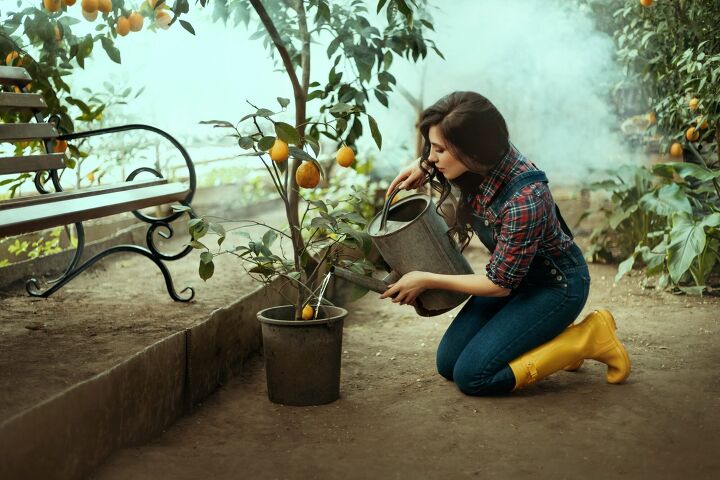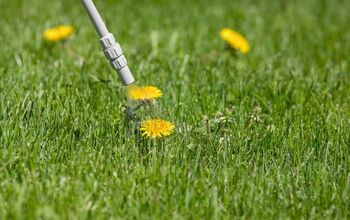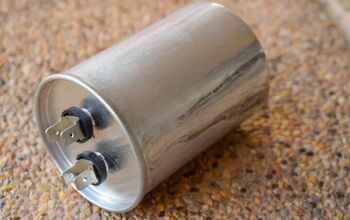Why Are My Lemon Tree Leaves Turning Yellow?

How great is it to step outside and pluck a lemon from your tree to garnish a drink or make fresh-squeezed lemonade? Fresh fruit trees are a great addition to your yard space and garden. But if your lemon tree leaves are turning yellow, you might be worried that your homemade lemonade days are numbered.
Overwatering and nutrient deficiency turn lemon tree leaves yellow. Low temperatures, drought, pests, and lack of sunshine also lead to yellowing. Place your lemon tree in a place with full sun and monitor soil moisture levels. Eliminate pests with natural methods and bring lemon trees indoors when temperatures go below 50 degrees Fahrenheit at night.
Don’t despair when lemon tree leaves turn yellow. You can battle the causes of yellow leaves with a few easy tips to revive your tree.
Reasons Your Lemon Tree Leaves Are Yellow
Several reasons could be to blame for the yellow leaves on your lemon tree. Here’s an overview of the five main reasons why your lemon tree leaves are turning yellow and what to do about them.
1. Too Much Water
Lemon trees prefer warm climates where the soil stays somewhat dry between watering sessions. If you water your lemon tree too much, the roots take on excess moisture, leading to yellow leaves.
If you grow your lemon tree in a pot, using a base without drainage holes can also contribute to excess moisture around the roots.
2. Nutrient Deficiency
A lack of proper nutrients is another common reason for yellow lemon tree leaves. If lemon trees lack specific nutrients like nitrogen, zinc, iron, or magnesium, this can cause yellow leaves or yellow spots.
You may notice leaves drooping in addition to the yellowing. Lemon trees in pots are susceptible to nutrient deficiencies, since there’s limited room for soil (so fewer nutrients).
3. Low Temperatures
Lemon trees thrive in warm climates, so when temperatures start to dip, it can lead to yellow leaves. Frost and low temps can also lead to leaf drop, especially in younger trees. If you live in a region that experiences occasional frosts, look into a Meyer Lemon tree.
4. Drought
Although overwatering is a primary reason for yellow lemon tree leaves, lack of water can also lead to yellowing. If you notice the leaves turning yellow and shriveling, this is a sign of drought.
If the soil becomes too dry, it can become very hard, causing water to roll away instead of soaking down into the roots. This can occur with not watering enough or intense temperatures and sun that lead to excessive drying.
5. Lack Of Sunlight
Intense sun and heat could lead to dry soil that prevents enough water from reaching your lemon tree’s roots. But lemon trees still love the sun, and lack of sunlight will lead to yellow leaves. When sunlight is few and far between, leaves will lose their bright green color and drop.
6. Pests
Some bugs are good for your garden. But many pests, including aphids, spider mites, rust mites, and whiteflies (among others), can infest your lemon tree and bring disease. These pests can also drain nutrients from the leaves, leading to yellowing and yellow spots.
How Do You Fix Yellow Leaves On A Lemon Tree?
Once you know the reasons for yellow lemon tree leaves, you can devise a plan to fix the problem. It is possible to get your yellow leaves looking green again in many cases.
1. Get Rid Of Pests
Since you’re dealing with fruit, it’s best to avoid using chemicals and pesticides to eliminate pests. Instead, choose natural methods, like Neem or Jojoba oil.
You can also mix up a homemade spray. Here are two to try.
- Add one tablespoon of baking soda to a gallon of water and mix in two tablespoons of canola oil.
- In one gallon of water, mix two tablespoons of baking soda, five tablespoons of hydrogen peroxide, and two tablespoons of olive oil soap.
To treat your lemon trees, spray the mixture of your choice on your tree’s leaves and branches. Cover everything thoroughly to make it as difficult as possible for bugs to remain on the plant. The slippery, the better!
2. Get A Good Balance Of Sunlight
Locate your lemon tree in the sunniest place in your yard for the best results. If you need to bring the tree indoors, place it in a sunny window.
It may take some time for your tree to acclimate to indoor conditions, but providing as much sun as possible helps. If the air is too dry, routinely mist the leaves to help balance things out for your lemon tree.
3. Don’t Let Your Lemon Tree Get Too Cold
If you live in an area with cold winters, the ideal situation in the winter is a heated greenhouse. This way, you get a consistent temperature and maintain the benefits of full sun.
But if you don’t have a greenhouse, bring your tree indoors, and place it in a sunny window. This is good practice when nighttime temps are set to drop below 50 degrees Fahrenheit.
4. Avoid Drought
If your lemon tree is inside, drier air could lead to moisture loss, turning leaves yellow. Make sure not to place lemon trees near heaters and similar heat sources. Mist the leaves regularly to help keep them well-adjusted.
Don’t be too scared of overwatering, so you end up not watering enough. Aim to give your lemon tree a healthy soak once a week until a trickle of water comes out of the bottom of the pot.
During times of intense heat and dryness, carefully monitor the soil around your lemon tree. You might need to water more frequently during these times.
5. Fertilize Your Lemon Tree
Use a citrus fertilizer monthly during the spring and summer to give your lemon tree the proper amount of nutrients. However, there can always be too much of a good thing.
Using too much fertilizer can also lead to droopy, yellow leaves. Therefore, read the manufacturer’s instructions and follow them carefully.
6. Know How Often You Should Water A Lemon Tree
How often you need to water your lemon tree depends a lot on your climate. If you get a lot of rain where you live, you won’t need to water as often. Likewise, if you’re somewhere with a lot of humidity, it’s important to account for the extra moisture in the air.
On the contrary, if you live in a dryer region, you may find that more frequent watering is necessary. If the soil tends to dry out more quickly where you live, failing to water enough will lead to drought.
When you water your lemon tree, give it a good soak so that water can reach the roots. However, you want the top layer of the soil, about two inches, to dry out in between watering.
You may need to monitor the moisture level the first few times you water your lemon tree to adjust your watering schedule. Typically, a good place to start is once a week, but be prepared to adjust the frequency as needed.
In addition to the proper watering schedule, it’s also important to encourage proper drainage. If you place lemon trees in pots, use pots with holes in the base. If placing the pot in a tray, empty the excess water in the tray so it doesn’t keep the soil wet.
Avoiding slow-draining soils is also a good way to keep the moisture level in check. Use well-draining soil when using pots for your lemon trees. A recommended balance for your mix is ⅓ garden compost, ⅓ multi-purpose compost, and ⅓ perlite.
Can Yellow Lemon Tree Leaves Turn Green Again?
If your lemon tree leaves start to turn yellow, don’t give up hope. With proper watering, fertilizing, and sun, many trees will make an impressive comeback. Monitor the soil to make sure it has proper moisture levels, and use a citrus fertilizer once a month during the spring and summer.
If you notice pests are a problem, opt for natural methods over chemicals, and fully soak the leaves and branches with your preferred spray. With these tips and a watchful eye, you’ll be back to puckering your lips over some deliciously sour homemade lemonade in no time.
Related Guides:

Stacy Randall is a wife, mother, and freelance writer from NOLA that has always had a love for DIY projects, home organization, and making spaces beautiful. Together with her husband, she has been spending the last several years lovingly renovating her grandparent's former home, making it their own and learning a lot about life along the way.
More by Stacy Randall



























